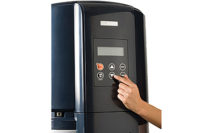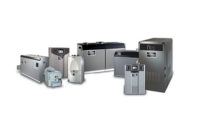In April 2010, the http://energy.gov/ U.S. Department of Energy issued new efficiency standards for residential storage water heaters — gas-fired, oil-fired and electric — and gas-fired tankless water heaters. These efficiency standards become effective in April 2015.
The current efficiency standards for gas-fired storage units require an Energy Factor of 0.59. The new standards will require gas-fired water heaters less than 55 gal. to have an EF of 0.62 and gas-fired units more than 55 gal. to have an EF of 0.76. For electric storage, standards will increase from the current 0.90 EF to 0.95 for units less than 55 gal. and 2.00 for units more than 55 gal.
Efficiency standards for oil-fired storage water heaters will increase from the current EF of 0.53 to 0.62. And gas-fired tankless water heaters will go from an EF of 0.62 to 0.82.
Energy Factor is defined as the measure of overall efficiency for a variety of appliances. For water heaters, the EF is based on three factors: the recovery efficiency, or how efficiently the heat from the energy source is transferred to the water; stand-by losses, or the percentage of heat lost per hour from the stored water compared to the content of the water; and cycling losses.
“By raising the energy-efficiency requirements of our everyday appliances, we will save money for American families and companies, reduce carbon pollution and enhance our energy security for decades to come,” DOE Secretary Steven Chu said in announcing the new requirements. The DOE notes the new requirements will decrease energy usage in large electric water heaters by 47% and by more than 30% in large gas water heaters.
“With so much money being funneled into inefficient water heating systems, it is critical for contractors to assist homeowners with selecting an efficient system in the early stages of home building or when replacing an older unit,” says Bridget Scanlon, director of residential and commercial programs for the http://www.propanecouncil.org/ Propane Education & Research Council. “By choosing an on-demand system such as a propane-fueled tankless water heater instead of a standard electric water heater, homeowners can reduce energy costs by up to 50% and reduce greenhouse gas emissions by up to 61%.”
Essentially, the new requirements will require water heater manufacturers to use more advanced technologies such as heat pump and condensing technology to increase energy efficiency. The http://www.ari.org/ Air-Conditioning, Heating and Refrigeration Institute stated that these technologies were “too expensive and not ready for widespread deployment,” the New York Times reports.
“In the long run, a shift to electric heat pump and condensing gas water heaters is absolutely essential if we are to make deep cuts in household energy use and costs,” counters Jeffrey Harris, vice president of national programs, http://www.ase.org/ Alliance to Save Energy.
To meet the amended standards, the DOE estimates that the average installed price of such equipment will increase by $120, which will be offset by savings of $143 over the life of the equipment. A 55-plus gal. gas water heater would have a median payback of 9.8 years, an electric water heater would have a 6-year payback, an oil-fired model would have a 6-month payback, and gas-fired tankless would have a payback of 14.8 years.
The new water heater requirements do not mean that consumers have to replace their water heaters in 2015. Like the low-flow toilet requirements of the early 1990s, the DOE mandate means that manufacturers cannot produce or sell lower-efficient water heaters after April 15, 2015.
Charles Smithof http://www.bradfordwhite.com/ Bradford White Corp. spoke in 2012 about the new water heater requirements. Manufacturers continue to work on designs incorporating condensing and heat pump technology without making them cost-prohibitive to consumers.






